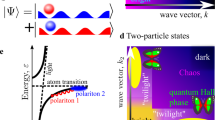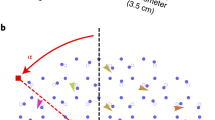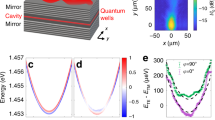Abstract
Topological physics relies on the structure of the eigenstates of the Hamiltonians. The geometry of the eigenstates is encoded in the quantum geometric tensor1—comprising the Berry curvature2 (crucial for topological matter)3 and the quantum metric4, which defines the distance between the eigenstates. Knowledge of the quantum metric is essential for understanding many phenomena, such as superfluidity in flat bands5, orbital magnetic susceptibility6,7, the exciton Lamb shift8 and the non-adiabatic anomalous Hall effect6,9. However, the quantum geometry of energy bands has not been measured. Here we report the direct measurement of both the Berry curvature and the quantum metric in a two-dimensional continuous medium—a high-finesse planar microcavity10—together with the related anomalous Hall drift. The microcavity hosts strongly coupled exciton–photon modes (exciton polaritons) that are subject to photonic spin–orbit coupling11 from which Dirac cones emerge12, and to exciton Zeeman splitting, breaking time-reversal symmetry. The monopolar and half-skyrmion pseudospin textures are measured using polarization-resolved photoluminescence. The associated quantum geometry of the bands is extracted, enabling prediction of the anomalous Hall drift, which we measure independently using high-resolution spatially resolved epifluorescence. Our results unveil the intrinsic chirality of photonic modes, the cornerstone of topological photonics13,14,15. These results also experimentally validate the semiclassical description of wavepacket motion in geometrically non-trivial bands9,16. The use of exciton polaritons (interacting photons) opens up possibilities for future studies of quantum fluid physics in topological systems.
This is a preview of subscription content, access via your institution
Access options
Access Nature and 54 other Nature Portfolio journals
Get Nature+, our best-value online-access subscription
$29.99 / 30 days
cancel any time
Subscribe to this journal
Receive 51 print issues and online access
$199.00 per year
only $3.90 per issue
Buy this article
- Purchase on Springer Link
- Instant access to full article PDF
Prices may be subject to local taxes which are calculated during checkout




Similar content being viewed by others
Data availability
The datasets generated and/or analysed during the current study are available in the Open Science Framework (OSF) repository at https://osf.io/s4rzu/?view_only=1cabd49416c04a9baed856dee3ae1ba9.
References
Berry, M. The quantum phase, five years after. In Geometric Phases in Physics (eds Wilczek, F. & Shapere, A.) 7–28 (World Scientific, 1989).
Berry, M. V. Quantal phase factors accompanying adiabatic changes. Proc. R. Soc. Lond. A 392, 45–57 (1984).
Hasan, M. Z. & Kane, C. L. Topological insulators. Rev. Mod. Phys. 82, 3045–3067 (2010).
Provost, J. & Vallee, G. Riemannian structure on manifolds of quantum states. Commun. Math. Phys. 76, 289–301 (1980).
Peotta, S. & Törmä, P. Superfluidity in topologically nontrivial flat bands. Nat. Commun. 6, 8944 (2015).
Gao, Y., Yang, S. A. & Niu, Q. Field induced positional shift of Bloch electrons and its dynamical implications. Phys. Rev. Lett. 112, 166601 (2014).
Piéchon, F., Raoux, A., Fuchs, J.-N. & Montambaux, G. Geometric orbital susceptibility: quantum metric without Berry curvature. Phys. Rev. B 94, 134423 (2016).
Srivastava, A. & Imamoglu, A. Signatures of Bloch-band geometry on excitons: nonhydrogenic spectra in transition-metal dichalcogenides. Phys. Rev. Lett. 115, 166802 (2015).
Bleu, O., Malpuech, G., Gao, Y. & Solnyshkov, D. D. Effective theory of nonadiabatic quantum evolution based on the quantum geometric tensor. Phys. Rev. Lett. 121, 020401 (2018).
Kavokin, A., Baumberg, J. J., Malpuech, G. & Laussy, F. P. (eds) Microcavities (Oxford Univ. Press, 2011).
Kavokin, A., Malpuech, G. & Glazov, M. Optical spin Hall effect. Phys. Rev. Lett. 95, 136601 (2005).
Terças, H., Flayac, H., Solnyshkov, D. D. & Malpuech, G. Non-Abelian gauge fields in photonic cavities and photonic superfluids. Phys. Rev. Lett. 112, 066402 (2014).
Haldane, F. D. M. & Raghu, S. Possible realization of directional optical waveguides in photonic crystals with broken time-reversal symmetry. Phys. Rev. Lett. 100, 013904 (2008).
Lu, L., Joannopoulos, J. D. & Soljačić, M. Topological photonics. Nat. Photon. 8, 821–829 (2014).
Ozawa, T. et al. Topological photonics. Rev. Mod. Phys. 91, 015006 (2019).
Sundaram, G. & Niu, Q. Wave-packet dynamics in slowly perturbed crystals: gradient corrections and Berry-phase effects. Phys. Rev. B 59, 14915–14925 (1999).
Yang, Z. et al. Topological acoustics. Phys. Rev. Lett. 114, 114301 (2015).
Cooper, N. R., Dalibard, J. & Spielman, I. B. Topological bands for ultracold atoms. Rev. Mod. Phys. 91, 015005 (2019).
Delplace, P., Marston, J. & Venaille, A. Topological origin of equatorial waves. Science 358, 1075–1077 (2017).
Zanardi, P., Giorda, P. & Cozzini, M. Information-theoretic differential geometry of quantum phase transitions. Phys. Rev. Lett. 99, 100603 (2007).
Liang, L., Peotta, S., Harju, A. & Törmä, P. Wave-packet dynamics of Bogoliubov quasiparticles: quantum metric effects. Phys. Rev. B 96, 064511 (2017).
Hauke, P., Lewenstein, M. & Eckardt, A. Tomography of band insulators from quench dynamics. Phys. Rev. Lett. 113, 045303 (2014).
Lim, L.-K., Fuchs, J.-N. & Montambaux, G. Geometry of Bloch states probed by Stückelberg interferometry. Phys. Rev. A 92, 063627 (2015).
Fläschner, N. et al. Experimental reconstruction of the Berry curvature in a Floquet Bloch band. Science 352, 1091–1094 (2016).
Wimmer, M., Price, H. M., Carusotto, I. & Peschel, U. Experimental measurement of the Berry curvature from anomalous transport. Nat. Phys. 13, 545–550 (2017).
Yu, M. et al. Experimental measurement of the quantum geometric tensor using coupled qubits in diamond. Natl Sci. Rev. nwz193 (2019).
Tan, X. et al. Experimental measurement of the quantum metric tensor and related topological phase transition with a superconducting qubit. Phys. Rev. Lett. 122, 210401 (2019).
Bleu, O., Solnyshkov, D. D. & Malpuech, G. Measuring the quantum geometric tensor in two-dimensional photonic and exciton-polariton systems. Phys. Rev. B 97, 195422 (2018).
Richter, S. et al. Exceptional points in anisotropic planar microcavities. Phys. Rev. A 95, 023836 (2017).
Nalitov, A. V., Solnyshkov, D. D. & Malpuech, G. Polariton ℤ topological insulator. Phys. Rev. Lett. 114, 116401 (2015).
Klembt, S. et al. Exciton–polariton topological insulator. Nature 562, 552–556 (2018).
St-Jean, P. et al. Lasing in topological edge states of a one-dimensional lattice. Nat. Photon. 11, 651–656 (2017).
Bleu, O., Malpuech, G. & Solnyshkov, D. D. Robust quantum valley Hall effect for vortices in an interacting bosonic quantum fluid. Nature Commun. 9, 3991 (2018).
Steger, M., Gautham, C., Snoke, D. W., Pfeiffer, L. & West, K. Slow reflection and two-photon generation of microcavity exciton–polaritons. Optica 2, 1–5 (2015).
Ballarini, D. et al. Macroscopic two-dimensional polariton condensates. Phys. Rev. Lett. 118, 215301 (2017).
Armitage, A. et al. Exciton polaritons in semiconductor quantum microcavities in a high magnetic field. Phys. Rev. B 55, 16395–16403 (1997).
Rahimi-Iman, A. et al. Zeeman splitting and diamagnetic shift of spatially confined quantum-well exciton polaritons in an external magnetic field. Phys. Rev. B 84, 165325 (2011).
Acknowledgements
We thank D. Colas for critical reading of the manuscript. This work was supported by the ERC project ElecOpteR (grant number 780757). We acknowledge the support of the project Quantum Fluids of Light (ANR-16-CE30-0021), of the ANR Labex Ganex (ANR-11-LABX-0014), and of the ANR program Investissements d’Avenir through the IDEX-ISITE initiative 16-IDEX-0001 (CAP 20-25). D.D.S. acknowledges the support of the IUF (Institut Universitaire de France). This work was partially supported by the FISR-CNR project "TECNOMED—Tecnopolo di nanotecnologia e fotonica per la medicina di precisione".
Author information
Authors and Affiliations
Contributions
A.G., L.D. and D.B. designed the setup. A.G. realized the experiments with the help of V.A., M.D.G. and G.L. D.S. supervised the experimental part. K.W.W. and L.N.P. fabricated the sample. O.B., D.D.S. and G.M. performed the treatment of the experimental data. O.B. performed analytical calculations. G.M. and O.B. wrote the manuscript with input from all authors.
Corresponding authors
Ethics declarations
Competing interests
The authors declare no competing interests.
Additional information
Peer review information Nature thanks Ulf Peschel and the other, anonymous, reviewer(s) for their contribution to the peer review of this work.
Publisher’s note Springer Nature remains neutral with regard to jurisdictional claims in published maps and institutional affiliations.
Extended data figures and tables
Extended Data Fig. 1 Experimental setup.
Schematic of the polarization tomography experiment. The incoming pump laser (bottom right) is focused onto the sample held in the cryogenic superconductive magnet (bottom left). The emission is recollected, polarization filtered and the momentum space optically rebuilt at the entrance slits of a spectrometer (top) with energy resolution of 30 µeV (top left). The Zeeman splitting is highlighted in the inset.
Supplementary information
Supplementary Information
The file contains five Supplementary Notes and six Supplementary Figures. The notes present the details of the data treatment, uncertainty estimates, and the analytical calculations. The figures show the examples of raw photoluminescence data and additional results on the Berry curvature and anomalous Hall effect.
Rights and permissions
About this article
Cite this article
Gianfrate, A., Bleu, O., Dominici, L. et al. Measurement of the quantum geometric tensor and of the anomalous Hall drift. Nature 578, 381–385 (2020). https://doi.org/10.1038/s41586-020-1989-2
Received:
Accepted:
Published:
Issue Date:
DOI: https://doi.org/10.1038/s41586-020-1989-2
This article is cited by
-
Evidence for chiral graviton modes in fractional quantum Hall liquids
Nature (2024)
-
Spin-selective strong light–matter coupling in a 2D hole gas-microcavity system
Nature Photonics (2023)
-
Observation of Zitterbewegung in photonic microcavities
Light: Science & Applications (2023)
-
Nonlinear electrical transport phenomena as fingerprints of a topological phase transition in ZrTe5
Communications Materials (2023)
-
Coupled quantum vortex kinematics and Berry curvature in real space
Communications Physics (2023)
Comments
By submitting a comment you agree to abide by our Terms and Community Guidelines. If you find something abusive or that does not comply with our terms or guidelines please flag it as inappropriate.



